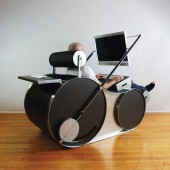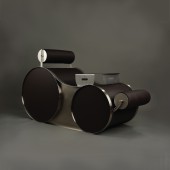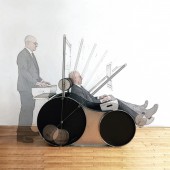Chotto Multifunctional Chair by Stroman Design |
Home > Winners > #61763 |
 |
|
||||
| DESIGN DETAILS | |||||
| DESIGN NAME: Chotto PRIMARY FUNCTION: Multifunctional Chair INSPIRATION: The development of this ergonomic system was inspired by my back surgery in 2006. This triggered my decision to pursue a less physically demanding career as an architect. As graduation approached in 2012, I dreaded the thought of spending increasing amounts of time sitting in front of a computer. With a very compelling personal interest, a heightened sensitivity to ergonomics, and an intuition that there must be a better response to this design challenge, I began to explore and develop a novel ergonomic approach to human computer interaction that centered not my computer display, but on my physical and mental wellbeing. UNIQUE PROPERTIES / PROJECT DESCRIPTION: The Chotto features an ideal weight displacing and active recumbent seating surface that decompresses both the cervical and lumbar spine. The seating surface also dynamically adapts to the weight, shape and movement of each occupant. Its pivoting headrest can be micro adjusted in up to 100 unique positions. A portable and adjustable tray provides a task surface for eating, reading, writing or digital interaction and can be used while in the seated or standing position. Internal storage drawers can also be easily accessed from both the standing and seated position. OPERATION / FLOW / INTERACTION: The Chotto can simultaneously accommodate up to two users in both a standing and seated position. By placing a portable tray within the rear support brackets, the Chotto performs as an adjustable standing desk. A seated user can also position an identical tray within side supports to interact with any materials or devices of their choice, such as a laptop, tablet or keyboard. By reaching overhead the seated user can easily pull down the pivoting display interface and micro adjust the display screen by rotating it within the larger display support arms. This allows the seated user to work independently or to collaborate with a standing user. PROJECT DURATION AND LOCATION: Prototyping of the Chotto began in NYC in 2015. The Chotto 1.0 was introduced and exhibited in NYC at the 2016 ICFF. The Chotto 2.0 was completed in NYC in 2017. FITS BEST INTO CATEGORY: Office Furniture Design |
PRODUCTION / REALIZATION TECHNOLOGY: The concept, distinct form and performance of the Chotto originated from combining two yoga balls with a seating surface. To maintain the dynamically adaptive response of a flexible surface and to provide stability, a rigid frame was required to support the pretensioned and adaptive seating surface of the Chotto. Further testing of various foams and fabrics helped produce the Chotto's unique muliti layer seating surface. Structural prototyping with various materials and fabrication technologies also played a key role in producing a production ready product by simplifying the Chotto's fabrication and assembly requirements. SPECIFICATIONS / TECHNICAL PROPERTIES: Base Model: L 1625 mm x W 762 mm x H 1066 mm TAGS: innovation, ergonomics, seating, standup desk, computer interaction RESEARCH ABSTRACT: Initial bio mechanical analysis rejected the widely accepted model of upright ergonomic seating for human computer interaction. Many physical ailments and losses in productivity can be attributed to this ergonomic approach. Responses to the Chotto from focus group and trade show participants consistently produce immediate and novel sensations of floating, decompression and disbelief. These reactions to the collective performance of the Chotto's unique geometry, dynamic seating surface and enhanced functionality fully support this evolutionary approach to ergonomic design. CHALLENGE: The design and integration of structural components to support the adaptive and flexible seating surface of the Chotto was the initial creative challenge. Fortunately, this minimalist design afforded several opportunities to easily integrate highly ergonomic and functional features. Culturally, the Chotto challenges the status quo by redefining what is possible within scope of ergonomic seating and human computer interaction. ADDED DATE: 2017-10-01 00:36:42 TEAM MEMBERS (1) : Thomas Stroman IMAGE CREDITS: Stroman Design, 2017. PATENTS/COPYRIGHTS: Patented: Patent No. USD754451S1, Thomas Stroman, 2015, USA Patent Pending: USA, China, Europe |
||||
| Visit the following page to learn more: http://www.stromandesign.com | |||||
| AWARD DETAILS | |
 |
Chotto Multifunctional Chair by Stroman Design is Winner in Furniture Design Category, 2017 - 2018.· Read the interview with designer Stroman Design for design Chotto here.· Press Members: Login or Register to request an exclusive interview with Stroman Design. · Click here to register inorder to view the profile and other works by Stroman Design. |
| SOCIAL |
| + Add to Likes / Favorites | Send to My Email | Comment | Testimonials | View Press-Release | Press Kit |
Did you like Stroman Design's Furniture Design?
You will most likely enjoy other award winning furniture design as well.
Click here to view more Award Winning Furniture Design.








